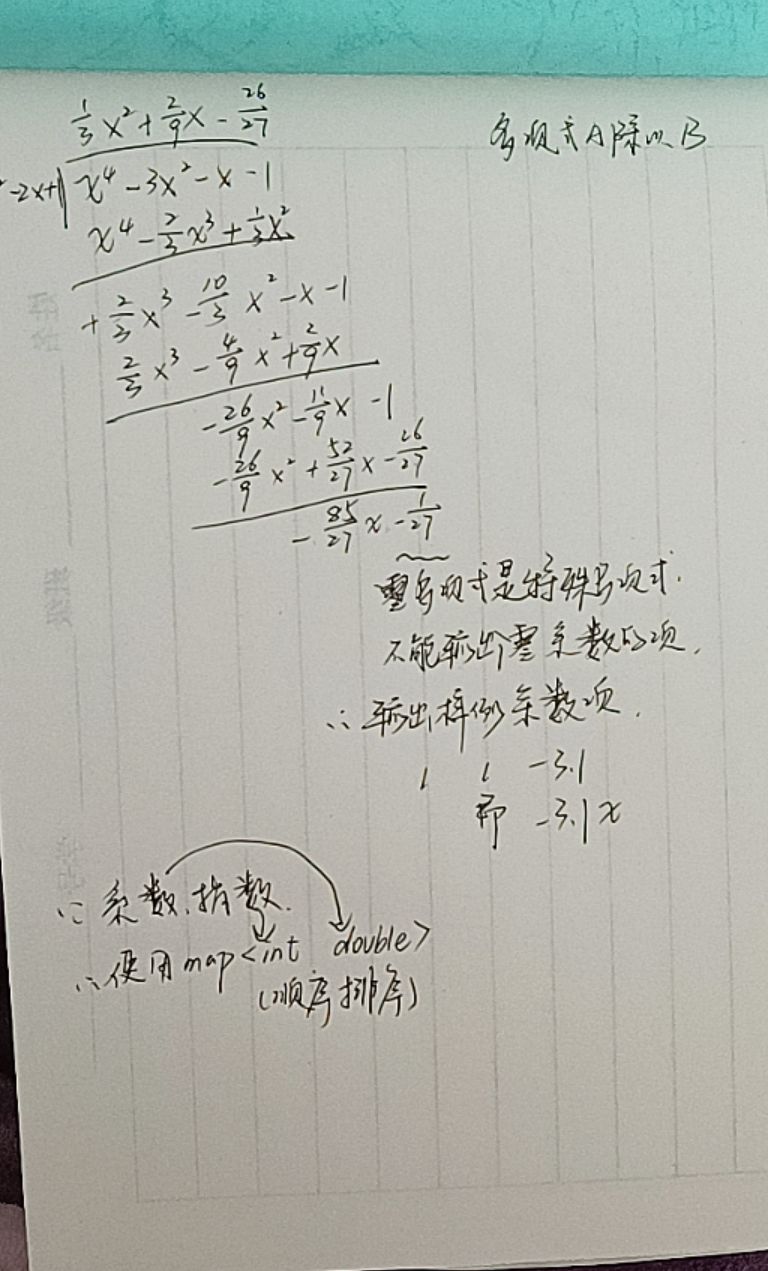two
L2-018 polynomial A divided by B (25 points)
This is still A question about A/B, but both A and B are replaced by polynomials. You need to calculate the quotient Q and remainder r of the division of two polynomials, where the order of R must be less than the order of B.
Input format:
The input is divided into two lines. Each line gives A non-zero polynomial, giving A first and then B. The format of each line is as follows:
N e[1] c[1] ... e[N] c[N]
Where N is the number of non-zero terms of the polynomial, e[i] is the exponent of the ith non-zero term, and c[i] is the coefficient of the ith non-zero term. Each item is given in the order of decreasing exponents to ensure that all exponents are different non negative integers, all coefficients are non-zero integers, and all integers are within the integer range.
Output format:
The quotient and remainder are output successively in two lines. The output format is the same as the input format, and the output coefficient retains 1 decimal place. The numbers in the same line shall be separated by one space, and there shall be no extra space at the beginning and end of the line. Note: Zero polynomial is a special polynomial, and the corresponding output is 0.0. However, non-zero polynomials cannot output terms with zero coefficients (including 0.0 after rounding). In the example, the copolynomial actually has a constant term of - 1 / 27, but it is not output because it is rounded to 0.0.
Input sample:
4 4 1 2 -3 1 -1 0 -1 3 2 3 1 -2 0 1
Output example:
3 2 0.3 1 0.2 0 -1.0 1 1 -3.1
Problem solving ideas

Step 1:
1. There are coefficients and indexes, so map is used to store data types
map<int,double>a; //remainder map<int,double>b; //Divisor map<int,double>c; //merchant
2. Initialize polynomials
① Initialization of a
int lena; //Number of items in a
cin>>lena;
for(int i=0;i<lena;i++)
{
int e; //index
double c; //coefficient
cin>>e>>c;
maxe_a=max(maxe_a,e); //Find the highest index of a
a[e]=a[e]+c;
}② Initialization of b
Note: b also needs to find a minimum number of times
int lenb; //Number of items in b
cin>>lenb;
for(int i=0;i<lenb;i++)
{
int e; //index
double c; //coefficient
cin>>e>>c;
mine_b=min(mine_b,b); //Find the lowest sub index of b
maxe_b=max(maxe_b,e); //Find the highest index of a
b[e]=b[e]+c;
}Step 2: division operation
1. Calculation times:
(maxe_a-maxe_b)+1, i.e. for (int i = maxe_a; I > = maxe_b; I --)
That is, perform several division operations
2. Supplier:
The coefficient of current a is: the highest power coefficient of current a / the highest power coefficient of b
The index of current a is: the highest power of current a - the highest power of current b
Remainder item c: the item that has not been truncated to 0
One of the terms of quotient is the highest power coefficient of current a divided by the highest power coefficient of b
The same is true of the index
Why add a current?
----->Each time the highest item of a is eliminated by (the highest item of b * one item of the corresponding quotient) until a finally becomes the remainder of the requirement
------>The remainder term is the term in which the coefficient is not reduced to 0 after the difference of each term of a (each term of b * the quotient of the corresponding term)
for(int i=maxe_a;i>=maxe_b;i--) //Number of division operations
{
if(b[maxe_b]!=0) //When the coefficient of b is not 0
{
div=1.0*a[i]/b[maxe_b]; //Coefficient of c
sub=i-maxe_b; //Index of c
c[sub]=div; //remainder
maxe_c=max(maxe_c,sub); //The largest exponent in the remainder
for(int j=i;j>=mine_b;j--) //Update vendors
{
if(j-sub>=0) //When the index is not 0
a[j]=a[j]-b[j-sub]*c[sub]; //merchant
}
}
}3. Rounding operation
for(int i=maxe_c;i>=0;i--)
{
c[i]=(double)((int)(c[i]*10+(c[i]<0?-0.5:0.5)))/10;
if(c[i])
cnt++;
}Original code of the whole program
#include<iostream>
using namespace std;
#include<map>
#include<algorithm>
#include<cmath>
int main()
{
map<int,double>a;
map<int,double>b;
map<int,double>c;
int lena,lenb;
int maxe_a=0,maxe_b=0,maxe_c=0,mine_b=10000;
double div;
int sub;
cin>>lena;
for(int i=0;i<lena;i++)
{
int e;
double c;
cin>>e>>c;
maxe_a=max(maxe_a,e);
a[e]=a[e]+c;
}
cin>>lenb;
for(int i=0;i<lenb;i++)
{
int e;
double c;
cin>>e>>c;
mine_b=min(mine_b,e);
maxe_b=max(maxe_b,e);
b[e]=b[e]+c;
}
for(int i=maxe_a;i>=maxe_b;i--)
{
if(b[maxe_b]!=0)
{
div=1.0*a[i]/b[maxe_b];
sub=i-maxe_b;
c[sub]=div;
maxe_c=max(maxe_c,sub);
for(int j=i;j>=mine_b;j--)
{
if(j-sub>=0)
a[j]=a[j]-b[j-sub]*c[sub];
}
}
}
int cnt=0;
for(int i=maxe_c;i>=0;i--)
{
c[i]=(double)((int)(c[i]*10+(c[i]<0?-0.5:0.5)))/10;
if(c[i])
cnt++;
}
if(cnt==0)
printf("0 0 0.0\n");
else
{
cout<<cnt;
for(int i=maxe_c;i>=0;i--)
{
if(c[i])
printf(" %d %.1lf",i,c[i]);
}
printf("\n");
}
cnt=0;
for(int i=maxe_a;i>=0;i--)
{
a[i]=(double)((int)(a[i]*10+(a[i]<0?-0.5:0.5)))/10;
if(a[i])
cnt++;
}
if(cnt==0)
printf("0 0 0.0\n");
else
{
cout<<cnt;
for(int i=maxe_a;i>=0;i--)
{
if(a[i])
printf(" %d %.1lf",i,a[i]);
}
printf("\n");
}
return 0;
}
summary
1. Distinguish quotient and remainder. c is quotient and a is remainder
2. For the first large cycle, determine the coefficient and index of one quotient at a time
3. The second small cycle updates the remainder a, a[j]=a[j]-b[j-sub]*c[sub]\
4. Rounding operation:
a[i]=(double)((int)(a[i]*10+(a[i]<0?-0.5:0.5)))/10;